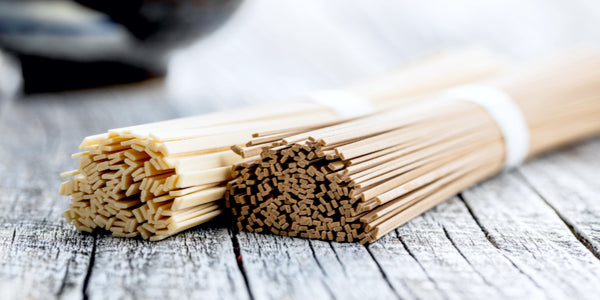
Japan is considered one of the countries with one of the highest life expectancies in the world. A major factor contributing to this is the traditional Japanese diet which is high in vegetables, fish, soybean products and low in sugar, meats, and processed foods.
Japanese cuisine is rich in a variety of plant-based foods including two types of noodles: udon and soba. These noodles can be found in most major grocery stores and can be an easy template to create a balanced meal.
Both yakisoba and udon noodles are iconic meal choices from the Japanese culture. We breakdown the differences and nutritions of each and how to use them.
What Is Udon?
Udon noodles have three simple, basic ingredients: wheat flour, salt, and water. Udon noodles are a thicker, chewy type of noodle common in broth-based soups often served with meat and vegetables.
Other udon dishes include:
• Zaru Udon: A cold noodle dish with a dipping sauce
• Kake Udon: A simple dish of udon noodles served in a broth
• Kitsune Udon: Udon noodles served in a hot or cold broth and topped with thinly sliced, deep-fried sheets of tofu.
• Curry Udon: Udon noodles served hot with a Japanese curry broth
• Yaki Udon: Stir-fry udon noodles with vegetables and protein
Dried udon noodles can be found in most large or specialty grocery stores and can be cooked like pasta in boiling water. You can also make udon noodles, as the ingredients are simple and probably on hand.
What Is Yaki Soba?
Similar to udon noodles, yakisoba (or simply soba for short) noodles are made from just a few ingredients: buckwheat flour and water. The buckwheat flour adds a nutty, earthy flavor to the noodles. Soba noodles are traditionally used as a base for cold salads, hot soups, or stir fry dishes. They are cut thinner compared to the larger udon noodles.
Soba noodles are mainly available dried, although using freshly made soba noodles may have a superior taste and texture. However, making your own soba noodles may not be as simple as making udon. According to Bon Appetit, making soba noodles is a complicated process that can take years to truly master.
What Are the Nutritional Values of Each Noodle?
Udon and soba noodles are similar in all macronutrients, including carbohydrates, protein, and fat. Below details the nutritional breakdown of udon and soba noodles for a two-ounce portion:
Both varieties of noodles can also be made from whole grain flour. Udon is made from whole wheat flour. Soba noodles are made from buckwheat flour, which is gluten-free, but packaged soba usually also contains wheat flour. Therefore, check labels before assuming soba noodles will be gluten-free before cooking and enjoying a soba dishThese noodles are naturally low in fat and higher in carbohydrates. Both are also a great source of B vitamins and iron. Adding in vegetables and protein with these noodles will bump up the nutrient levels of a meal with these noodles.
Cooking with Udon and Soba Noodles
Each of the noodles can be used as a base for soups, cold noodle salads, and hot stir fry dishes. Instead of enjoying these noodles by themself, make a balanced meal by adding in plenty of vegetables and an animal or plant-based protein source.
For example, this sesame soba noodles recipe with edamame has soba and edamame dressed with a sweet chili soy sauce. Other nutritious and delicious soba combos include:
• Soba soup with shrimp and greens with soba, shrimp, soft boiled egg, and leafy greens.
• Ginger carrot soba noodles that can be made in 30 minutes for a flavorful cold soba salad.
• Ginger miso udon soup with tofu served in a hot broth to warm you up on a cold winter day.
Overall, the options with either type of Japanese noodle are endless for experimenting in the kitchen!






